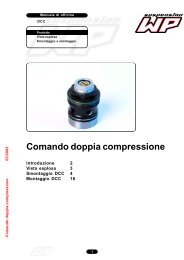Understanding ECU Remapping: The Audi TT 1.8 T - contiman - Free
Understanding ECU Remapping: The Audi TT 1.8 T - contiman - Free
Understanding ECU Remapping: The Audi TT 1.8 T - contiman - Free
You also want an ePaper? Increase the reach of your titles
YUMPU automatically turns print PDFs into web optimized ePapers that Google loves.
<strong>Understanding</strong> <strong>ECU</strong> <strong>Remapping</strong>: <strong>The</strong> <strong>Audi</strong> <strong>TT</strong> <strong>1.8</strong>T Variants/Bosch Motronic ME7.x<br />
RPM LDRXNZK (%) LDRXN (%) LDRXNZK (%) LDRXN (%)<br />
1000 97.0 97.0 99.0 99.0<br />
1720 128.1 128.1 129.8 129.8<br />
2000 139.9 140.6 148.5 148.5<br />
2100 143.6 147.4 154.5 154.5<br />
2200 145.6 146.7 160.5 155.3<br />
2520 148.5 140.8 176.3 166.5<br />
3000 148.2 138.3 176.3 166.5<br />
3520 146.5 140.9 176.3 166.5<br />
4000 148.2 144.0 182.3 166.5<br />
4520 159.4 15<strong>1.8</strong> 188.3 177.0<br />
5000 160.2 151.7 183.0 185.3<br />
5520 157.7 157.7 168.8 17<strong>1.8</strong><br />
5900 155.8 155.3 162.0 168.8<br />
6000 153.2 153.0 153.8 160.5<br />
6400 142.3 142.3 141.0 148.5<br />
6800 130.1 130.1 135.0 144.0<br />
Remarks for LDRXN: these maps contain the most significant differences between the two states of tune<br />
(BAM & BFV) of any of the primary maps discussed so it seems reasonable to assume that adjusting these<br />
profiles will bring about the most noticeable effect. Note that the peak in LDRXN is around 5500 to 5700 rpm<br />
which corresponds to the point at which peak power is achieved in the BAM and BFV engines. LDRXN can<br />
be set to near maximum by some professional tuners as a means of sacrificing some safety margin in the<br />
pursuit of higher output. Although this represents the short-circuit of a safety feature, it is perhaps deemed<br />
sufficient for only timing to be retarded during knock rather than both timing to be retarded and charge<br />
pressure to be reduced. However, considering that the output profile I logged on my car using lower octane<br />
fuel than the remap was designed for is actually close to stock (peaking at only 234 bhp), it appears likely<br />
that a reasonable safety margin has been retained.<br />
Remarks for LDRXNZK: It is noted in module LDRLMX 3.100 that the values should be set about 15% lower<br />
than LDRXN which would be reasonable from an intuitive understanding; i.e. overall ignition advance is<br />
reduced during knock so maximum allowable cylinder charge should also be reduced. However, in these<br />
examples, the values in LDRXNZK are actually higher from around 2,300 to between 5,000 and 5,500 rpm.<br />
<strong>The</strong> only plausible explanation is that a slightly larger cylinder charge is allowed to counteract the suboptimal<br />
peak cylinder pressure and consequential loss of torque that would result from sub-optimal ignition<br />
timing due to knock. Otherwise, the driver would feel a noticeable step-change in power during the onset of<br />
knock. If in doubt, don’t try to second-guess the OEM calibrator; follow the advice in the funktionsrahmen and<br />
set the values in LDRXNZK a bit lower than LDRXN.<br />
<strong>The</strong> characteristic field KFTARX (Kennfeld Maximalfuellung Tans Korrekturfaktor) corrects the ‘rlmx’ path by<br />
a multiplication factor as a function of engine speed and IAT. Notice that up to and including an IAT of 30°C,<br />
the correction factor is 1.00, between 30°C and 70°C, a slight charge pressure increase is applied to<br />
counteract the loss of power resulting from warmer, lower density intake air then above 70°C, the charge<br />
pressure is progressively reduced for safety. I observe typical IATs of 8-11°C above ambient air temperature<br />
during normal driving conditions so in the U.K., even at the height of summer, IATs are unlikely to rise above<br />
45°C, therefore Motronic will be applying minimal charge pressure correction. For this reason, there ought to<br />
be no strong requirement to adjust these IAT correction maps.<br />
KFTARX (Kennfeld Maximalfüllung Temperatur Ansaugluft Korrekturfaktor, Map for IAT correction factor to<br />
maximum charge). Units (x,y,z): °C, RPM, ratio<br />
-10 10 30 50 70 80 90 110 130 143<br />
1000 1.00 1.00 1.00 1.000 1.000 0.95 0.85 0.75 0.75 0.75<br />
1700 1.00 1.00 1.00 1.000 1.000 0.95 0.85 0.75 0.75 0.75<br />
2000 1.00 1.00 1.00 1.036 1.012 0.95 0.85 0.75 0.75 0.75<br />
2200 1.00 1.00 1.00 1.051 1.042 0.95 0.85 0.75 0.75 0.75<br />
2520 1.00 1.00 1.00 1.056 1.056 0.95 0.85 0.75 0.75 0.75<br />
3000 1.00 1.00 1.00 1.026 1.061 0.95 0.85 0.75 0.75 0.75<br />
3520 1.00 1.00 1.00 1.023 1.060 0.95 0.85 0.75 0.75 0.75<br />
4000 1.00 1.00 1.00 1.010 1.059 0.95 0.85 0.75 0.75 0.75<br />
5000 1.00 1.00 1.00 1.043 1.039 0.95 0.85 0.75 0.75 0.75<br />
22



